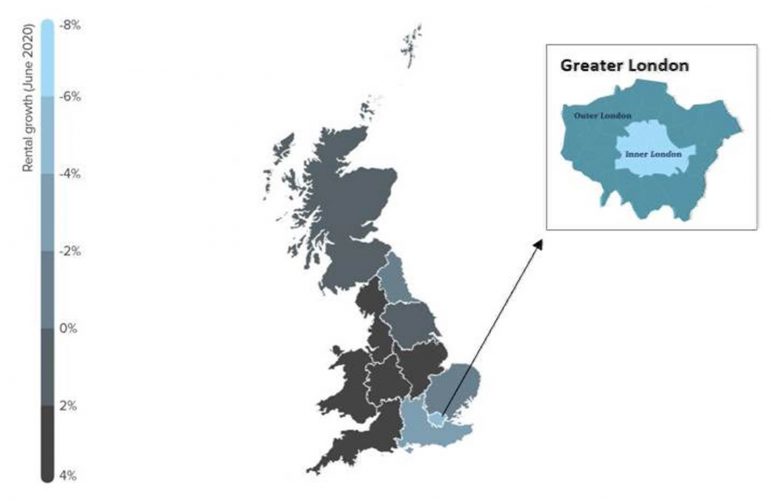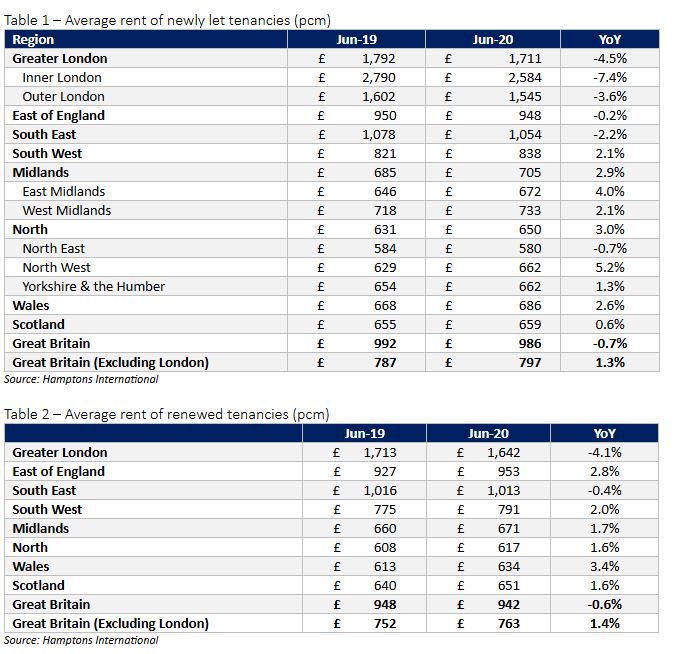The Hamptons International Monthly Lettings Index for June has been published.
Average rents on newly let properties fell 0.7% in Great Britain in June, marking the first fall since February 2014.
Rental growth has significantly declined from 3.8% recorded in June 2019 and a 1.2% rise in February 2020 (pre-lockdown).
London saw the biggest rent falls (-4.5%) last month, driven by a record decline in Inner London where rents fell 7.4% year-on-year (chart 1).
Higher stock levels (+14%) in the capital combined with a fall in applicant numbers (-9%) explain the decline.
Meanwhile outside of London, rents continued to rise. Average rents on newly let properties increased 1.3% in June, with the North West recording the strongest rental growth of 5.2% which is the highest rate since November 2016 (table 1).
Chart 1 – Rental growth across the regions (pre and post lockdown)
During lockdown and acting on advice not to move home, fewer people took out new rental agreements so Hamptons did not to run their core lettings index which focusses on achieved rents on newly let properties. Instead they looked at how rents on renewed tenancies have changed.
Last month, sample sizes were robust enough for them to report for the first time on how the economic damage caused by the coronavirus has impacted rents on newly let properties (i.e. those let to new tenants as opposed to existing tenancies being renewed).
In June, the average rent on a newly let property in Great Britain fell to £986 pcm, – 0.7% or £6 below the same time last year (table 1).
This marked the first annual fall since February 2014 and a deceleration in rental growth from pre-lockdown times when rents were rising at an annual rate of 1.2% in February 2020 and 3.8% in June 2019.
In June 2020, rents fell in four out of eleven regions, with London recording the biggest decline.
The average rent of a newly let property in the capital dropped 4.5% year-on-year in June, the biggest decline since the index began in 2014.
This was driven by a 7.4% year-on-year fall in Inner London, marking the biggest decrease on record and all but wiping out last year’s rental growth of 7.5%.
Rents in Outer London decreased -3.6% year-on-year in June (table 1, chart 1).
However outside of London, rents continued to rise by an average of 1.3% year-on-year in June. Increasing rental growth in the Midlands (2.9%) and North (3.0%) outweighed rent falls in the South East (-2.2%), the North East (-0.7%) and the East of England (-0.2%).
The North West recorded the strongest rental growth of 5.2%, which is the highest rate of growth recorded in the region since November 2016 (table 1).
The imbalance between supply and demand explains the regional differences.
Chart 2 – ratio of applicants to the number of homes available to rent
Overall in Great Britain there were 5% fewer applicants looking to rent in June compared with the same period last year, while the number of homes available to rent fell 10% year-on-year. As a result, there were 6.3 tenants looking for every home available to rent.
London was the only region where stock levels increased from last year, and when combined with a fall in demand, it explains why the capital saw the biggest rent falls.
There were 14% more homes available to rent in the capital last month compared with the same period last year.
This was mainly due to an increase in the number of short-let properties moving to the long-term rental market, particularly in Inner London where stock levels were up 26% year-on-year.
It coincided with a 9% year-on-year fall in the number of applicants looking to rent a home in the capital.
Fewer international tenants and an increase in the number of people moving out of London in search of more space drove the fall in applicants.
As a result, there were 3.9 applicants looking for every property available, down from 4.9 in June 2019 (chart 1).
Meanwhile in the North West, the region recording the strongest rental growth last month, demand heavily outweighed supply.
Stock levels in the region fell 26% year-on-year while the number of people looking to rent increased 6%.
As a result, there were 12.1 applicants looking for every property available to rent, the highest ratio in the country, and up from 8.4 in June last year (chart 1).
Commenting Aneisha Beveridge, Head of Research at Hamptons International, said:
“Activity in the rental market has returned to pre-lockdown times, with the number of new tenancies agreed last month rising to February levels.
“Last month’s data gives us a first look at how rents on newly let properties have been affected by the economic damage so far, and it’s clear that there are regional differences.
“In June rents fell in three out of the eleven regions in Great Britain, with London recording the deepest decline.
“Rising stock levels in the capital, particularly in Inner London, combined with falling demand from new applicants caused the record falls.
“The effect of lockdown has resulted in fewer international tenants, particularly students, as well as an increase in the number of London tenants leaving the capital.
“However the flexibility renting offers has boosted demand in the Midlands and North.
“Rents in the three combined Northern regions rose 3.0% in June, six times the rate recorded in the same period last year.
“While the stamp duty changes announced last week are most likely to benefit landlords looking to buy in London and the South, higher yields will continue to entice investors further North.
“Any additional increase in rental stock in London could put more downward pressure on rents.
“But longer-term, the prospects for rental growth in the capital will depend on whether the short-term increase in supply remains, and most importantly, what the lasting economic damage means for rental affordability.”






Comments are closed.